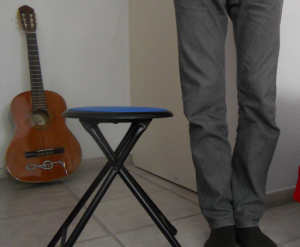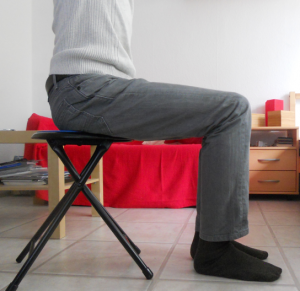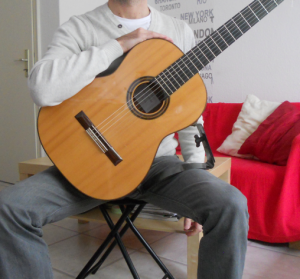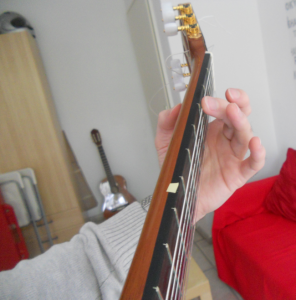In this short tutorial, I want to show you how to hold your guitar correctly.
Before we start to learn our first chords to play the guitar, we have to hold it correctly. Holding the guitar properly does not only influence your whole picking and strumming techniques but is also very important to prevent medical problems with your back in the future, after several years of playing the guitar. We start with the right sitting position and the according angles of the guitar and your hands. But for “coolness” and convenience reasons, we will talk about a few relaxed positions for everyday and outdoor usage at the end of the article too.
Most Ideal Position
When I took guitar lessons myself, I was taught the “ideal” position over years. During my researches and in conversations with other guitarists, this position was confirmed widely as the standard or the “best” position. I want to show you this position before we talk about more casual positions.
First of all, we need a chair in addition to our acoustic guitar. The chair should not be an office chair with wheels and should not have armrests. A stool, a little bit smaller than a normal chair should fit the best. Wheels would make it roll back when playing the guitar and are a no-go for that reason.
When sitting on the stool, it is important that your back stays vertical and straight. If your chair has a backrest, do not touch it with your back. You should sit far forward at the chair to bring your back in a straight position. There are special guitar stools available in stores, but a simple stool from your kitchen or basement should fit. The height of the stool depends on how tall you are, but generally it should have the same height as your knees (see the picture above). If you have a piano chair at home which can be adjusted in height, that would fit perfectly by the way.
The picture above illustrates, how to sit on the chosen chair. Your thighs should be in a horizontal position, and the back as mentioned should be in a straight and vertical position. Do never chose a sitting position that is exhausting. You should sit relaxed, but not crooked. When choosing the wrong position in the beginning, it will be hard to retrain and change it later and this could result in medical problems with your back in the worst case.
Holding the guitar
In this article (and in following articles), I assume that you are right-handed. In case you are left-handed, just switch every instruction for the right hand to your left and vice versa.
The most common way to hold the guitar is by using a guitar footstand. Those are cheap and easy to use. If you do not want to buy one, you can use any item (e.g. a book) big enough to hold your foot in the right position. The height of the footstand depends on your body sizes and I can not give a rule of thumb for that. It should be adjusted according to the following aspects of holding the guitar. You can use an Ergoplay Guitar Support or similar guitar rests attached directly to the guitar. I use one of those myself because it is said that the conventional foot stands can affect the back negatively over time.
The footstand or the Guitar support are used to hold the guitar in the right position. Ideally, the head of the guitar should be nearly the height of your eyes. This seems a bit high at first, but is the traditionally standard position for holding a classical guitar. I recommend to hold the guitar like this especially in the beginning to prevent to fall into wrong habits. Not holding the guitar in such a steep position would result in your back tilted to the left. Always control yourself to hold the back straight.
Your right elbow lies on the top “corner” of the guitar body. The right elbow holds the guitar in position and against your chest. Some people prefer to hold the guitar slightly tilted to have a better view at the fretboard. But do not use any pressure or tense your right arm. It has always to be relaxed and should rest on your guitar more than holding it. You can see the described holding position of the guitar in the picture above. Both arms should be totally relaxed in this position (the right arm is lying completely on the guitar when not playing it).
Position of your Hands
Now that we are sitting correctly and holding the guitar properly, the question is what we do with our hands. We start with the right hand, which we use for picking or strumming the strings to create the sound.
The right hand
The right hand should be held in a high arch. My guitar teacher always said that a tennis ball should fit through the wrist and the strings. This would be a bit too much in fact, but nevertheless it is a good way to practise the right position of your arm / hand. You will caught yourself by holding the hand flatter and flatter over time, so be sure to check the position time by time. Your thumb should rest on or better should be hold right above the topmost string (E) while the other fingers are free to pick all the other strings. Even when you are only strumming with your thumb in the beginning, the high arch and the angle of your wrist should be the same. I will explain different picking techniques in future tutorials and you will have a big advantage when you already hold your hand correctly. In the picture above i show the right position of the right hand from your point of view.
The left hand
The left hand is used to press the strings against the fretboard to modify the pitch of the strings. This hand is never used to hold the guitar in position. If you feel a tension in the left hand / arm because you have to support the position of the guitar with it, than you should check your general sitting position with the tips given in the previous paragraphs.
We grab the guitar neck with the whole hand. The thumb of your left hand always stays behind the neck. It is never (Never! – Even if it may look cool when some rock guitarist do it) used on the fretboard. This can be done by experts for fun or show reasons, but it is a bad technique. To press the strings against the fretboard, we only use the other four fingers.
The fingers of your left hand should always stay in a steep position to the fretboard. There will be some chords where you will have to lower the angle (e.g. holding a so called barré chord) but we will come to this later.In the picture below you can see the ringfinger in such a steep position right before pressing the string.
When pressing the upper strings (E, A), th thumb should not change its position (in height). Instead, the whole arm moves a bit forward to hold the steep position of the other fingers. You can see this movement of the hand/arm in the picture below. Compared with the picture above you can see that the whole arm is moved a bit forward.
The left hand should be able to move along the whole neck of the guitar. Starting at the body of the guitar up to the head. Therefore, the angle of the elbow changes while moving the hand up or down.
Alternative positions
As mentioned at the beginning of the article, there are some common ways to hold the guitar without caring about all those exact instructions above. But it is important to know how to hold the guitar correctly before you try out those more “flexible” positions. When practising at home, you should always use the technic described above to get used to it. Afterwards you will find yourself transferring and using some of the described details when using the other positions.
Crossed legs
Sometimes you have no footstand around or the right stool is missing. In this case there is a common position which can be used on nearly any chair (without armrests). You simply cross your legs and put the guitar on top of them. Some people say that it should be the right leg above the left one (in case you are right-handed) but i think this is a matter of taste. I prefer the left leg over the right one for example, because I can hold the guitar neck a bit higher in this position, which is more similar to the standard position described in this article.
No Footstand
Another commonly used position is to simply omit the footstand. Therefore you put the guitar directly on your left leg. This is done by some professional guitar players too, but I this position makes it harder to hold the guitar neck up and does lead to a tilted back automatically. When I am too lazy to get my guitar support out of the closet, I use this position too. But as already mentioned, it is a bit more exhausting and I can not use it when practising for more than 10 minutes.
Like in every tutorial article, we will improve the contents of this article over time. Are there any positions / tips we missed here? Feel free to leave a comment.
Continue reading this series: How to Tune a Guitar >>
Browse the other parts of this article series:- How To Buy Your First Acoustic Guitar
- How to hold the guitar
- How to Tune a Guitar









